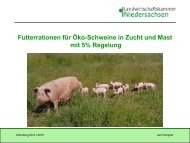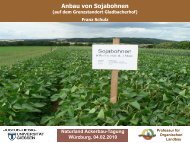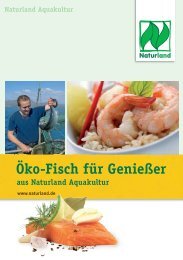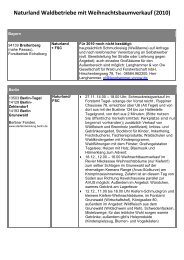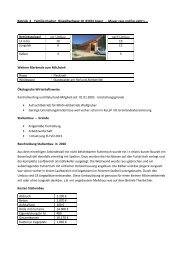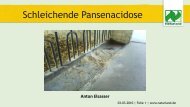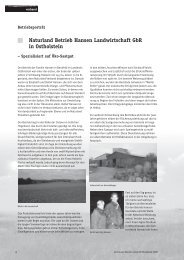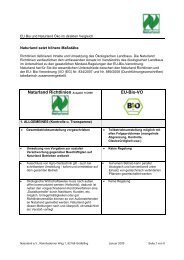Organic Farming in the Tropics and Subtropics: Hibiscus - Naturland
Organic Farming in the Tropics and Subtropics: Hibiscus - Naturland
Organic Farming in the Tropics and Subtropics: Hibiscus - Naturland
Create successful ePaper yourself
Turn your PDF publications into a flip-book with our unique Google optimized e-Paper software.
II Special section: <strong>Organic</strong> <strong>Hibiscus</strong> Cultivation<br />
Information pr<strong>in</strong>ted on transport packag<strong>in</strong>g<br />
The transport packag<strong>in</strong>g should display details of <strong>the</strong> follow<strong>in</strong>g:<br />
• Name <strong>and</strong> address of <strong>the</strong> manufacturer/packer <strong>and</strong> country of orig<strong>in</strong><br />
• Description of <strong>the</strong> product <strong>and</strong> its quality class<br />
• Year harvested<br />
• Net weight, number<br />
• Batch number<br />
• Dest<strong>in</strong>ation, with <strong>the</strong> trader’s/importer’s address<br />
2 3<br />
• Visible <strong>in</strong>dication of <strong>the</strong> organic orig<strong>in</strong> of <strong>the</strong> product<br />
Storage<br />
The dried hibiscus blossoms should be stored <strong>in</strong> dark areas at low temperatures<br />
(maximum 15-20°C) <strong>and</strong> relative humidity (max. 60 %). Under optimum conditions,<br />
dried hibiscus blossoms can be stored for around 12-18 months.<br />
If <strong>the</strong> organic product is be<strong>in</strong>g stored <strong>in</strong> a s<strong>in</strong>gle warehouse toge<strong>the</strong>r with<br />
conventional hibiscus mix<strong>in</strong>g of <strong>the</strong> different qualities must be avoided. This is best<br />
achieved us<strong>in</strong>g <strong>the</strong> follow<strong>in</strong>g methods:<br />
Tra<strong>in</strong><strong>in</strong>g <strong>and</strong> <strong>in</strong>form<strong>in</strong>g of warehouse personnel<br />
Explicit signs <strong>in</strong> <strong>the</strong> warehouse (silos, pallets, tanks etc.)<br />
Colour differentiation (e.g. green for <strong>the</strong> organic product)<br />
Incom<strong>in</strong>g/dispatched goods separately documented (warehouse logbook)<br />
It is prohibited to carry out chemical storage measures (e.g. gass<strong>in</strong>g with methyl<br />
bromide) <strong>in</strong> mixed storage spaces. Wherever possible, stor<strong>in</strong>g both organic <strong>and</strong><br />
conventional products toge<strong>the</strong>r <strong>in</strong> <strong>the</strong> same warehouse should be avoided.<br />
2 When products from organic farms are be<strong>in</strong>g declared as such, it is necessary to adhere to <strong>the</strong><br />
requisite government regulations of <strong>the</strong> import<strong>in</strong>g country. Information concern<strong>in</strong>g this is available from<br />
<strong>the</strong> appropriate certification body. The regulation (EEC) 2092/91 is applicable to organic products be<strong>in</strong>g<br />
imported <strong>in</strong>to Europe.<br />
3 <strong>Organic</strong> products must be protected from contam<strong>in</strong>ation by non-compliant substances at each stage<br />
<strong>in</strong> <strong>the</strong> process, i.e. process<strong>in</strong>g, packag<strong>in</strong>g, shipp<strong>in</strong>g. Therefore, products orig<strong>in</strong>at<strong>in</strong>g from a certified<br />
organic farm must be recognisably declared as such.<br />
Naturl<strong>and</strong> e.V. – 1 st edition 2000 page 10



